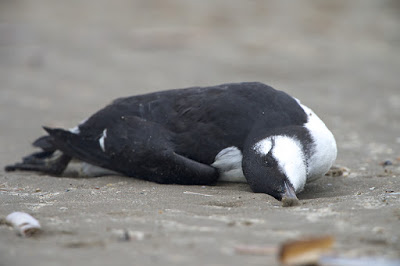
Alaskan bird die off update: "The number is totally off the charts!" Nearly 10,000 dead murres on a 1-mile stretch of beach along with hundreds of dead star fish...Lack of food blamed
The Big Wobble

Anyone who has walked Homer's beaches the past few weeks has seen a horrid event.
Every few yards along the tidal wrack line, the white chests of dead birds stand out among kelp and driftwood.
Some of the seabirds have been scavenged, a new food source that's caused an influx of bald eagles not seen on the Homer Spit since the death in 2009 of Jean Keene, Homer's Eagle Lady who used to feed eagles.
Something is killing Alaska's common murres.
In the summer of 2015, the murres also suffered a complete colony collapse and failed to breed. Almost all the dead birds are murres, seabirds that in the summer swim in huge rafts near Gull Island or offshore.
On a still summer evening, huge flocks can be seen flying just feet above the ocean surface.
With big, duck-like feet, black backs and white breasts, they look like penguins.
On land they're helpless, but on sea they can swim and dive deep.
Bird experts advise beach walkers to leave carcasses alone.
Many of the murres appear emaciated and have starved to death, but scientists studying the die off don't yet know what's causing the murres to starve.
Not only are murres starving, they're not breeding.
Surveys of breeding colonies in Kachemak Bay and on the Barren Islands last summer showed no murres set up nests.
Murres usually have a breeding success rate of 50 to 60 percent.
"We had complete reproductive failure, which is really rare for murres," said Heather Renner, a bird biologist with the Alaska Maritime National Wildlife Refuge.
Hundreds and even thousands of murres have washed up dead on Alaska beaches in Kodiak, Homer, Anchor Point, Kenai and Whittier.
In Seward, Anchorage, Palmer, Wasilla and Talkeetna, people also have been finding live, stranded birds in yards or on rivers and lakes - way outside the normal winter range for murres.
By January, murres usually have migrated out to sea.
The Bird Treatment and Learning Center in Anchorage has taken in 220 murres since Jan. 1, said Katie Middlebrook, avian rehabilitation coordinator.
At the Alaska SeaLife Center in Seward, 87 stranded murres have come in, said Laurie Morrow, education director and interim director of communications.
Morrow said live murres have shown up as far inland as Mile 12 Seward Highway.
On New Year's Day, a retired U.S. Fish and Wildlife Biologist counted 8,000 dead murres on a 1-mile stretch of beach in Whittier.
"That number is totally off the charts," Renner said.
"This whole region is having through-the-roof numbers in the last couple of days."
Lani Raymond, a Homer birder who has volunteered with the Coastal Observation and Seabird Survey Training program since 2009, did her monthly COASST survey of a ¾-mile stretch of beach along Mud Bay heading east from the access road to the beach from the old airport parking lot.
She counted 118 dead murres and also saw hundreds of dead sea stars.
"It's really bad," Raymond said.
"It's really depressing.
The day we did the 118 murres and all those star fish, I was really upset."
One day a month, COASST volunteers walk local stretches of beaches to look for dead birds.
They count, tag and photograph dead birds and report information to the national COASST program in Seattle.
Raymond said there have been so many dead birds they've been counting and photographing every 10 birds.
"Usually you go for a walk.
You might find a bird, but often you don't," she said.
"Right now it's the pits, really the pits."
Renner said local COASST volunteers have reported similar numbers as Raymond's survey, with some sections having from 400 to 800 birds per kilometer.
People have seen birds in woods above the high tide line, floating with debris in the Homer Harbor and even on the road.
COASST volunteers first noticed an increase in dead murres starting in July, when surveys showed about 2-3 dead birds per kilometer.
Julia Parrish, a fisheries professor at the University of Washington, Seattle, and executive director of COASST, called that amount "elevated."
In an interview in July, she said a big die off would be like one seen at Kayak Island near Prince William Sound, with 1,000 dead birds per kilometer.
http://www.thebigwobble.org/2016/01/alaskan-bird-die-off-update-number-is.html
